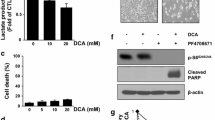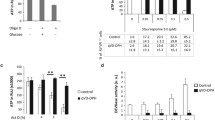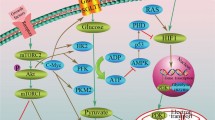Abstract
Most tumor cells exhibit a glycolytic phenotype. Thus, inhibition of glycolysis might be of therapeutic value in antitumor treatment. Among the agents that can suppress glycolysis is citrate, a member of the Krebs cycle and an inhibitor of phosphofructokinase. Here, we show that citrate can trigger cell death in multiple cancer cell lines. The lethal effect of citrate was found to be related to the activation of apical caspases-8 and -2, rather than to the inhibition of cellular energy metabolism. Hence, increasing concentrations of citrate induced characteristic manifestations of apoptosis, such as caspase-3 activation, and poly-ADP-ribose polymerase cleavage, as well as the release of cytochrome c. Apoptosis induction did not involve the receptor-mediated pathway, since the processing of caspase-8 was not attenuated in cells deficient in Fas-associated protein with Death Domain. We propose that the activation of apical caspases by citrate could be explained by its kosmotropic properties. Caspase-8 is activated by proximity-induced dimerization, which might be facilitated by citrate through the stabilization of intermolecular interactions between the proteins.






Similar content being viewed by others
References
Halicka HD, Ardelt B, Li X, Melamed MM, Darzynkiewicz Z (1995) 2-Deoxy-d-glucose enhances sensitivity of human histiocytic lymphoma U937 cells to apoptosis induced by tumor necrosis factor. Cancer Res 55(2):444–449
Geschwind JF, Ko YH, Torbenson MS, Magee C, Pedersen PL (2002) Novel therapy for liver cancer: direct intraarterial injection of a potent inhibitor of ATP production. Cancer Res 62(14):3909–3913
Cao X, Fang L, Gibbs S, Huang Y, Dai Z, Wen P, Zheng X, Sadee W, Sun D (2007) Glucose uptake inhibitor sensitizes cancer cells to daunorubicin and overcomes drug resistance in hypoxia. Cancer Chemother Pharmacol 59(4):495–505. doi:10.1007/s00280-006-0291-9
Bonnet S, Archer SL, Allalunis-Turner J, Haromy A, Beaulieu C, Thompson R, Lee CT, Lopaschuk GD, Puttagunta L, Harry G, Hashimoto K, Porter CJ, Andrade MA, Thebaud B, Michelakis ED (2007) A mitochondria-K+ channel axis is suppressed in cancer and its normalization promotes apoptosis and inhibits cancer growth. Cancer Cell 11(1):37–51. doi:10.1016/j.ccr.2006.10.020
Garland PB, Randle PJ, Newsholme EA (1963) Citrate as an intermediary in the inhibition of phosphofructokinase in rat heart muscle by fatty acids, ketone bodies, pyruvate, diabetes, and starvation. Nature 200:169–170
Hatzivassiliou G, Zhao F, Bauer DE, Andreadis C, Shaw AN, Dhanak D, Hingorani SR, Tuveson DA, Thompson CB (2005) ATP citrate lyase inhibition can suppress tumor cell growth. Cancer Cell 8(4):311–321. doi:10.1016/j.ccr.2005.09.008
Velichko MG, Trebukhina RV, Ostrovskii IuM (1981) Features of pyruvate and lactate metabolism in tumor-bearing rats following citrate administration. Vopr Med Khim 27(1):68–72
Zhang X, Varin E, Allouche S, Lu Y, Poulain L, Icard P (2009) Effect of citrate on malignant pleural mesothelioma cells: a synergistic effect with cisplatin. Anticancer Res 29(4):1249–1254 (pii 29/4/1249)
Halabe Bucay A (2009) Hypothesis proved citric acid (citrate) does improve cancer: a case of a patient suffering from medullary thyroid cancer. Med Hypotheses 73(2):271. doi:10.1016/j.mehy.2009.03.018
Bucay AH (2011) Clinical report: a patient with primary peritoneal mesothelioma that has improved after taking citric acid orally. Clin Res Hepatol Gastroenterol 35(3):241. doi:10.1016/j.clinre.2010.12.011
Bustamante E, Morris HP, Pedersen PL (1981) Energy metabolism of tumor cells. Requirement for a form of hexokinase with a propensity for mitochondrial binding. J Biol Chem 256(16):8699–8704
Yousefi S, Owens JW, Cesario TC (2004) Citrate shows specific, dose-dependent lympholytic activity in neoplastic cell lines. Leuk Lymphoma 45(8):1657–1665. doi:10.1080/10428190310001603920
Halabe Bucay A (2007) The biological significance of cancer: mitochondria as a cause of cancer and the inhibition of glycolysis with citrate as a cancer treatment. Med Hypotheses 69(4):826–828. doi:10.1016/j.mehy.2007.02.002
Tweddle DA, Malcolm AJ, Bown N, Pearson AD, Lunec J (2001) Evidence for the development of p53 mutations after cytotoxic therapy in a neuroblastoma cell line. Cancer Res 61(1):8–13
Sirzen F, Heiden T, Nilsson A, Bergh J, Skog S, Lewensohn R (1997) Characterisation of the G1/S cell cycle checkpoint defect in lung carcinoma cells with different intrinsic radiosensitivities. Anticancer Res 17(5):3381–3386
Zu XY, Zhang QH, Liu JH, Cao RX, Zhong J, Yi GH, Quan ZH, Pizzorno G (2012) ATP citrate lyase inhibitors as novel cancer therapeutic agents. Recent Pat Anticancer Drug Discov 7(2):154–167 (pii PRA-EPUB-20120220-001)
Schwartz L, Abolhassani M, Guais A, Sanders E, Steyaert JM, Campion F, Israel M (2010) A combination of alpha lipoic acid and calcium hydroxycitrate is efficient against mouse cancer models: preliminary results. Oncol Rep 23(5):1407–1416
Salvesen GS, Dixit VM (1999) Caspase activation: the induced-proximity model. Proc Natl Acad Sci USA 96(20):10964–10967
Boatright KM, Renatus M, Scott FL, Sperandio S, Shin H, Pedersen IM, Ricci JE, Edris WA, Sutherlin DP, Green DR, Salvesen GS (2003) A unified model for apical caspase activation. Mol Cell 11(2):529–541 (pii S1097276503000510)
Pop C, Fitzgerald P, Green DR, Salvesen GS (2007) Role of proteolysis in caspase-8 activation and stabilization. Biochemistry 46(14):4398–4407. doi:10.1021/bi602623b
Acknowledgments
The authors thank Prof. Marie Henriksson and Dr. John Inge Johnsen (Karolinska Institutet, Sweden) for providing cell lines used in the study and Prof. Peter Krammer and Dr. Inna Lavrik (DKFZ, Heidelberg, Germany) for the caspase-8 antibody. We are indebted to Dr. Magnus Olsson for the caspase-2 shRNA construct and Dr. Vitaliy Kaminskyy for his help in conducting experiments and fruitful discussions. The work was supported by grants from the Swedish Research Council, the Swedish and the Stockholm Cancer Societies, the Swedish Childhood Cancer Foundation, the EC FP-6 (Chemores), the Russian Ministry of High Education and Science (11.G34.31.0006), and the EC FP7 (Apo-Sys) programs.
Author information
Authors and Affiliations
Corresponding author
Rights and permissions
About this article
Cite this article
Kruspig, B., Nilchian, A., Orrenius, S. et al. Citrate kills tumor cells through activation of apical caspases. Cell. Mol. Life Sci. 69, 4229–4237 (2012). https://doi.org/10.1007/s00018-012-1166-3
Received:
Revised:
Accepted:
Published:
Issue Date:
DOI: https://doi.org/10.1007/s00018-012-1166-3




